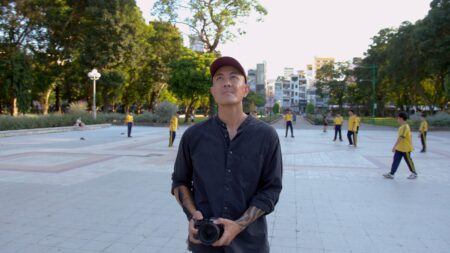Interview
“PROTECT PROTECT”

Jenny Holzer. Red Yellow Looming, 2004. Text: U.S. government documents. Lent by Cari and Michael J. Sacks. © 2008 Jenny Holzer, member Artists Rights Society (ARS), NY. Photo: Attilio Maranzano.
Curator Elizabeth Smith shares her thoughts on Jenny Holzer’s 2008 exhibition at the Museum of Contemporary Art, Chicago, PROTECT PROTECT.
ART21: Do you think all art is political? Do you think artists today have the power to effect political change?
SMITH: Jenny Holzer’s work, of course, is very political, although she does not want to be defined as a political artist.
I’m particularly interested in this whole notion of how you define political art today. How does it differ from earlier incarnations? What is the most effective way to create art that has a political message? Jenny has talked about how she likes her art to be socially useful, which I think is a very interesting and appropriate way to talk about the idea of political and social engagement in art.
ART21: Of all the shows you must be planning, how did you know this was the time to do a show with Jenny Holzer? Was it intentional on your part to have this show on view in time for the 2008 presidential election and inauguration?
SMITH: That’s a great question. Jenny is someone whose work I’ve known for a long time and someone I think that many of us have been familiar with for a while. And I have to say…I wasn’t thinking a lot about Jenny’s work during the past few years. But it all changed for me when I saw a show of her silkscreens at Cheim & Reid in New York. I was really struck by the fact that she was moving in this direction and that she was engaging with political material that she, herself, did not write, but had selected from these very interesting sources.
At the same time, we also have some work in the MCA Chicago’s permanent collection by Jenny Holzer…some early pieces that are fairly regularly placed on public view. I had begun to notice how visitors to the museum were really riveted by her small LED pieces. I, myself, would stand there and read the messages and take them in and think about them. They seemed newly fresh and relevant to me. And I noticed that that was also the effect they seemed to have on a number of our visitors to the museum. So it just felt right. I just really trusted my tuition that this would be an important moment to work with Jenny, even though I had never met her.
Jenny and I have been working together and talking about the show for about two years now. When we first began to discuss it, we weren’t quite sure how long it would take for her to develop her ideas into an exhibition. But as the content became clearer and the project that she wanted to develop became more defined, we knew it was going to focus on the recent work and have a more politically engaged slant.
As far as the people who were running for office in the 2008 elections…that was, of course, totally unknown and unforeseen. But we’re glad that Chicago turned out to be the seat of a lot of excitement related to current events. It wasn’t exactly intentional to have the show PROTECT PROTECT (2008-09) on view at this time, but we were very fortunate that Jenny was able to work with us to develop a show that could be presented at this historical moment and when we had an open slot on our schedule.
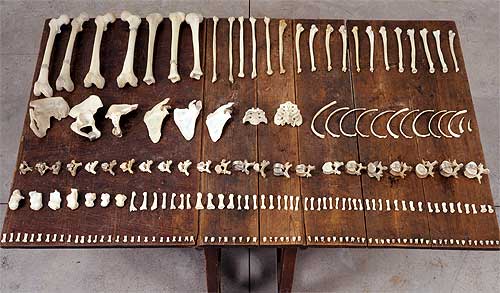
Jenny Holzer. Lustmord, 2007. Text: Lustmord, 1993-95. © 2008 Jenny Holzer, member Artists Rights Society (ARS), NY. Photo: Christopher Burke.
ART21: In one gallery you’ve paired an LED work with a table of bones—how did that striking juxtaposition come about?
SMITH: It was really Jenny’s choice to put those two pieces—Lustmord (1993-94) and Red Yellow Looming (2004)—in the same room. And now that I’ve seen how they’re installed and presented, and how they work together, I think it’s a very interesting choice. One is a cool, technological, large-scale element. The other sculptures are much more intimate, closer in scale to the human body, and are much more visceral.
She chose to include the bone tables from Lustmord because they had to do so profoundly with the experience of war. It was really the first body of writing accompanied by physical objects that dealt really directly with the horror of war and with the bodily trauma experienced people — primarily women — who were the victims of incredible violence during the Bosnian War in the former Yugoslavia.
So in this pairing we’re looking at the period in the early 1990s—Lustmord—and the years of the first Gulf War in Iraq—Red Yellow Looming—and I think that she felt that including these two works give the overall exhibition something of a historical background. These two works don’t focus just on the present moment; rather, they provide some history over a decade or period of fifteen years.
Jenny’s work is very timely and topical, but she also wants to be making a universal statement about war. So I think it’s rather important that she’s chosen to include pieces that make reference to wars in recent memory and not to just focus on the present moment.
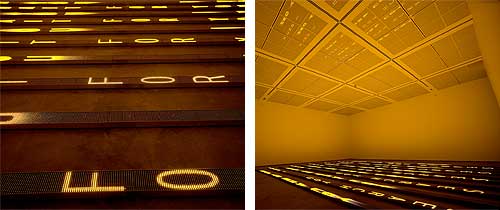
Jenny Holzer. For Chicago, 2008. © 2008 Jenny Holzer, member Artists Rights Society (ARS), NY. Photo: Lili Holzer-Glier
ART21: Could you say a little bit about the newest work, For Chicago (2008). Is it a site specific piece?
SMITH: For Chicago is a newly created piece that the museum commissioned for our collection. It came about, in part, because I was first talking with Jenny about the idea of doing a retrospective. And she fairly quickly convinced me that that really wasn’t the right way to go, because so much of her earlier work involved the presence of texts in public space. So much of it was work that you couldn’t recreate in a conventional museum/exhibition format. Instead, what we agreed on was to present a retrospective of all of her writings. So her texts from 1977 through 2001—when she stopped writing her own material—are all programmed into the piece For Chicago.
It’s a really significant work from that standpoint, because it presents so much information, so much material. It’s an LED sculpture, but it’s monumental in scale and it can be configured in different ways. We’re representing it on the floor of the gallery in the exhibition PROTECT PROTECT, but it can be positioned on the wall. It could be configured as one long line, going around a huge space. Some people might choose to put it on the ceiling. It has a lot of flexibility as a form, but it also has this amazing content that covers the entire early part of her career.
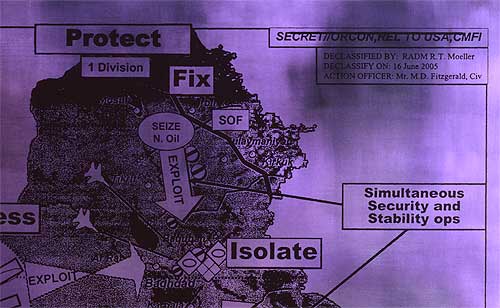
Jenny Holzer. Protect Protect deep purple, detail, 2007. Text: U.S. government document. © 2008 Jenny Holzer, member Artists Rights Society (ARS), NY. Photo: Christopher Burke.
ART21: We filmed one of Holzer’s first exhibitions of paintings back in 2006 for the Art in the Twenty-First Century television series on PBS. How do these new works fit in with the series and with this exhibition?
SMITH: In the exhibition, Jenny’s presenting a series of paintings based on a PowerPoint presentation that was given by the Pentagon to the White House, prior to the invasion of Iraq in 2003. The PowerPoint shows a group of maps of Iraq that are emblazoned with various phrases that make evident the Pentagon’s strategies.
One of the pieces has the words ‘Protect, Protect, Protect’ in three different zones (which inspired the title for the exhibition). And then it also contains language like ‘Seize,’ ‘Exploit,’ ‘Shock & Awe.’ It really makes you realize the agenda that was being set in place. And once you realize what you’re looking at—a PowerPoint proposal for what to do—it’s quite extraordinary.
It’s incredibly important information that she’s presenting to us. And although we all have access to these primary documents that Jenny has gathered from the website of the National Security Archive, the way that she presents it underscores the message so powerfully. She blows the documents up to a very large scale, and so they’re quite monumental. And then she’s colored each one of them differently. They’re all in hues of purple or grayish-green. Her idea was to make reference to the color of deep bruises on human flesh. A very powerful suggestion comes forth from those colors. At the same time the colors have a beauty, a kind of lyrical quality.
They’re alternately seductive and repulsive, and act on you in a profoundly physical way. It’s a great example in her work, I think, of how so much of her work is based on the act of reading. The forms in which she communicates the information are really meaningful in how we interpret it, how we take it in, and how it makes us feel. And I think that element of feeling and emotion is important to consider in Jenny Holzer’s work.
ART21: Jenny Holzer’s a fairly well-known contemporary artist, and yet it’s been a while since she’s had a major showing here in the U.S. How did that come to factor into your decision-making process behind the show?
SMITH: It’s pretty amazing that Jenny Holzer’s work hasn’t been seen in a major museum in the United States in almost 20 years. She’s been showing in Europe quite extensively during the past few years, so we really feel like we are reintroducing her to the American audience. Especially because the show presents a lot of newer work that people haven’t seen. It’s a new Jenny Holzer, in many respects.
I think a lot of us who have followed her work, who are familiar with it, think about a certain type of work that she became known for — her LED signs, her benches — pieces that are somewhat smaller in scale. But with this current exhibition she presents a number of LED sculptures that are monumental in scale, that are architectural. She’s also presenting for the first time a body of silk-screened paintings that are based on declassified United States government documents.
It’s a good time for us to be showing Jenny’s work; not just because of the content, but because we are presenting a major figure at the midpoint of her career and showing that she’s moving in a different direction. I think that’s really important. I think it’s really brave for an artist to continue to develop and push the envelope with their work. In Jenny’s case, although she’s been moving into new media and new directions, I think what’s interesting to consider is the consistency of the messages within her work. She’s always dealt with issues surrounding abuses of power. And she’s always caused passive viewers to become active questioners, in terms of how they read and understand and react to the materials she presents. In that respect, it’s a very consistent show…but at the same time, it also shows us a new Jenny Holzer.
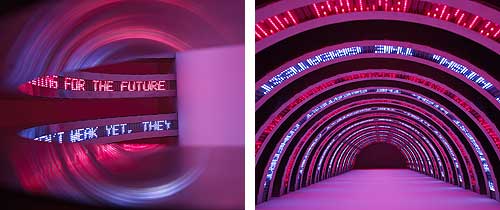
Jenny Holzer. MONUMENT, 2008. Text: Truisms, 1977-79 and Inflammatory Essays, 1979-82. © 2008 Jenny Holzer, member Artists Rights Society (ARS), NY. Photo: Vassilij Gureev.
ART21: In the exhibition, there seems to be this emphasis on bodies or corporeality as a theme. Is that new in Holzer’s work?
SMITH: I think in this show those qualities are much more pronounced than ever before in her work. It’s really given her a chance to bring together a number of different references to the body. In the text that Jenny, herself, has written for a long time—particularly in the 1990s up until 2001—there has been an increasing emphasis on the body and on a first-person sort of human experience. I think that this really comes forward, too, in the text that she’s programmed into her current LED pieces that are from declassified documents. There are references to the body throughout those texts. The autopsy reports, for instance, give very stark and very chilling renditions of the trauma endured by individuals who have been killed as a result of the current wars in Iraq and Afghanistan. Those references to the body are present throughout various texts in the exhibition.
But then also there’s this reference, sculpturally, that underscores that. You have that in some of the LEDs which are configured in a circular configuration reminiscent of a ribcage, for example. Or you have that in the images of hand prints taken from United States soldiers who were accused of war crimes. And then you have this bodily reference, presented very strongly, in a group of actual human bones that are laid out on old wooden tables. They’re chilling, sobering, and very startling, actual representations of the human body after death. So she has been able to interweave these different references — textually and sculptural, the object and the image, language and experience — in ways that all worked to intertwine and reinforce one another.

Jenny Holzer. Left Hand (Palm Rolled), 2007. Right Hand (Palm Rolled), 2007. PALM, FINGERS & FINGERTIPS 000406, 2007. PALM, FINGERS & FINGERTIPS 000407, 2007. Text for all: U.S. government document. © 2008 Jenny Holzer, member Artists Rights Society (ARS), NY.
ART21: What were the challenges in putting together the exhibition?
SMITH: I think I was probably naïve going into the project—because I should have realized this—but I didn’t until we actually started to work together: Jenny is very precise about language. And so when I was writing my essay for the catalog, I did what I do usually when I work with an artist: I share an early draft with them of my thoughts. I usually use that as a way to have a discussion, a dialogue with them back and forth about, about how to further develop the argument.
In this case, I wished I hadn’t done that. I should have given Jenny a much more polished, final version, because she’s incredibly precise about everything. So in retrospect, it took me a really long time to get my essay right, but it also did engender a really great back-and-forth between the two of us. Jenny really wanted to clarify a lot of the points that I was addressing rather cavalierly. So that was one interesting challenge. (LAUGHS)
Another challenge, of course, is the technology of her work. We are so dependent on programmers and fabricators and individuals from outside what is customarily considered “the art world” to make sure that the pieces are right and functioning well, especially because some of the works are new and are being made here on site. A large team of people has to be involved with the production of the works. That’s an area that’s not my forte. I’m more about content, not so much about the technique or technology. So it really has to be a team effort, but that’s actually a good challenge.

Jenny Holzer. Blue Cross, 2008. David Roberts Collection, London., © 2008 Jenny Holzer, member Artists Rights Society (ARS), NY. Photo: Lili Holzer-Glier.
ART21: Do feel like any of the works in the exhibition date themselves, by virtue of the period when the text was either written or appropriated? Or do the texts have a more timeless quality for you?
SMITH: Several pieces in the exhibition are new works that are programmed with older texts. It’s very interesting to read these texts and to think about them in relationship to the newer information that you find in the exhibition. I think there is a real resonance.
We can read a lot of the statements that Jenny wrote earlier in a way that underscores how current they still are, especially her series of texts called Inflammatory Essays (1979-82). Those were based on or inspired by her readings of manifestos by political figures, ranging from Mao Zedong to Vladimir Lenin and many others. She adopted the same kind of incendiary tone in those readings that appear almost hysterical and hyperbolic. When we think about the rhetoric, it’s so apparent and just everywhere in our country today — particularly at this moment, so near to a presidential election. It’s very interesting to relate or to think about her earlier words from the perspective of today. They seem very current and very fresh.
ART21: Do you ever find the references to violence in the work off-putting? What do you find redeeming about art that tackles such serious subject matter?
SMITH: Some of the content is certainly scary, and it’s horrifying. If you really take in what is said in some of the pieces that she presents—it scares you to death. You can’t believe how people can do these things to one another. But yet, that’s what’s recurred throughout human history. When you consider very recent occurrences in the world, like the current violence in the Congo, it is just absolutely excruciating. It sounds, to me, even more traumatic than what went on in the former Yugoslavia and elsewhere. I think it’s really scary and it makes you question human nature.
I think what Jenny’s demonstrating is that the concerns she’s dealing with now are not new in her work. She has always concerned herself with challenging abuses of power and with presenting different points of view about a subject and highlighting the confusion that surrounds us in the world today. To my mind, her work succeeds so well on the level of presenting or revealing uncertainties rather than truths. And I think that the way she causes us to reflect on these uncertainties is really powerful for us as viewers and as citizens.
This interview was originally published in two parts on the Art21 Magazine (Part 1, Part 2) in 2009.
